Team sports and exercise have been an essential part of my life since childhood. I took that love of sports in my college career, where I played volleyball for Queens University and the University of North Carolina Charlotte.
Although I enjoy pushing my body to its physical limits, I learned early on that one of the most important aspects of physical fitness, however, happens when I’m largely immobile: sleep.
An active lifestyle must be balanced by an investment in rest. Because athletes are often specialists in their sport of choice, their mattresses should be specialized as well. A muscular weightlifter or long-distance runner may not need the same features in a bed as me, a former collegiate volleyball player, for example.
In collecting this list of the best mattresses for athletes, I focused on beds that encourage comfort after a vigorous workout, but I also wanted to acknowledge that the word “athlete” contains multitudes. I selected mattresses that cater to a range of sports and exercise modalities in hopes that you’ll find the right match for your nightly cool-down.
Best Mattress for Athletes
- Bear Elite Hybrid – Editor’s Pick
- Helix Midnight – Best Mattress for Weightlifters
- Nectar Premier Copper – Best Mattress for Athletes with Shoulder Pain
- DreamCloud – Best Mattress for Runners
- WinkBed Plus – Best Mattress for Plus-Size Athletes
- Brooklyn Bedding Spartan – Best Mattress for Muscle Recovery
- Nolah Evolution – Best Cooling Mattress for Athletes
- Saatva Classic – Best Mattress for Athletes with Back Pain
- Bear Original – Best Firm Mattress for Athletes
Dr. Raj Discusses the Importance of Sleep for Athletes

Compare the Best Mattresses for Athletes
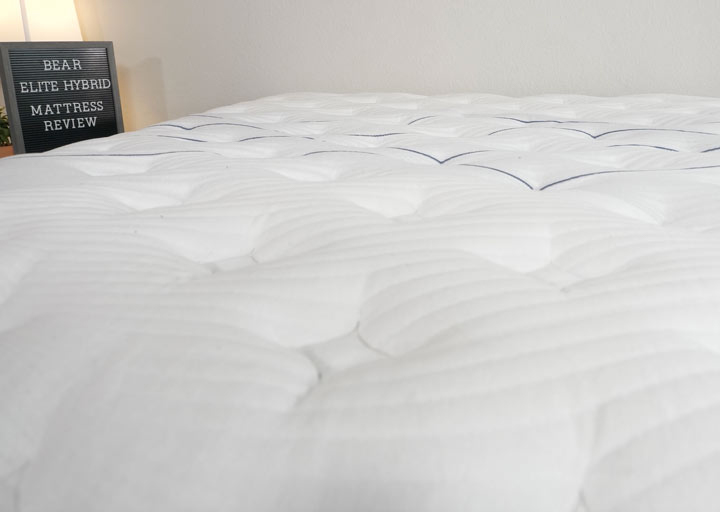
|
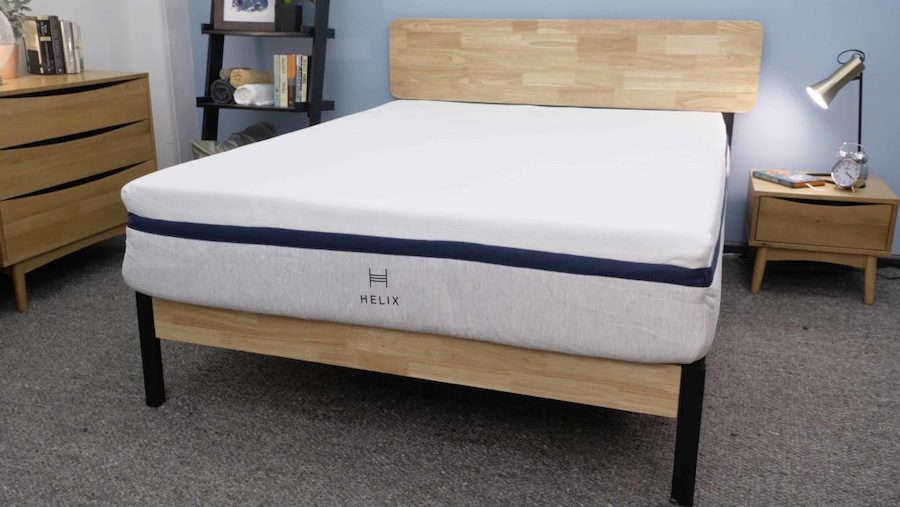
|
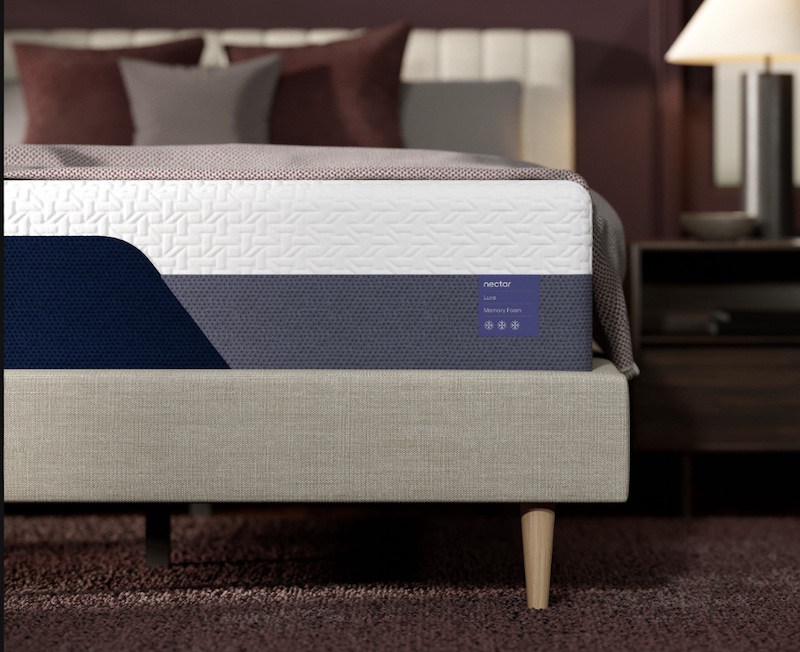
|
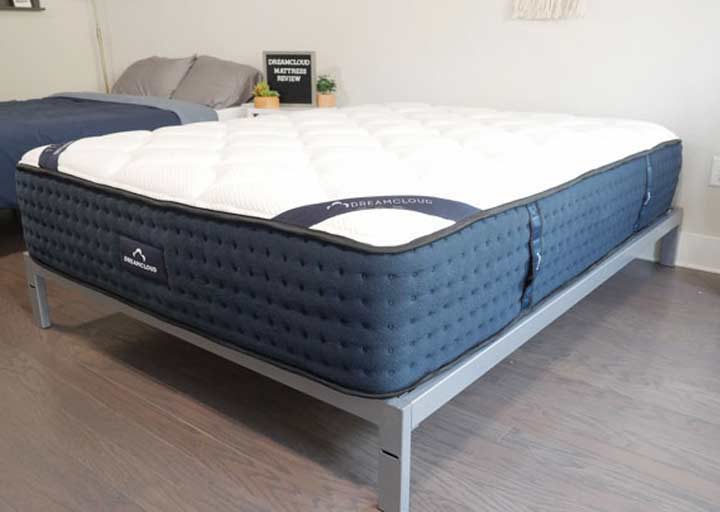
|
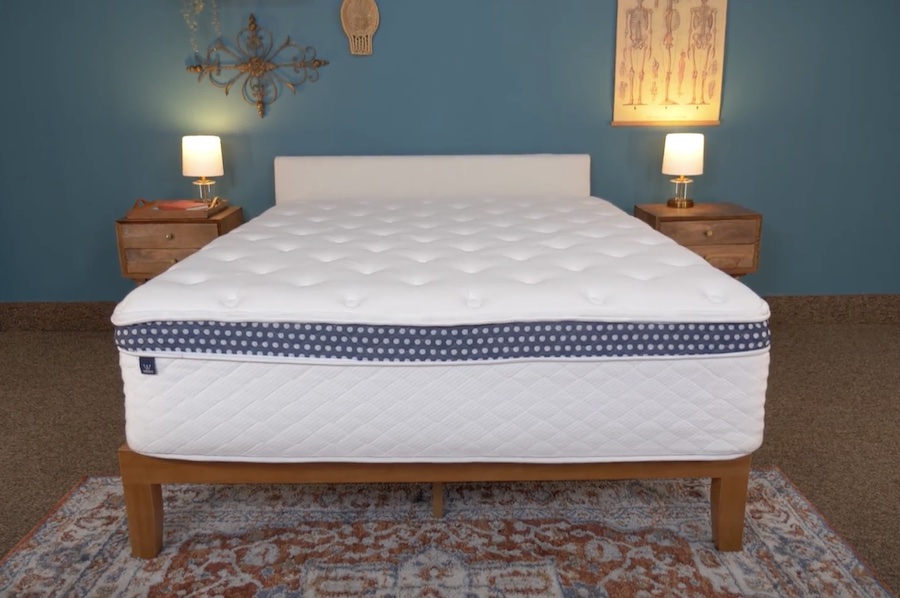
|
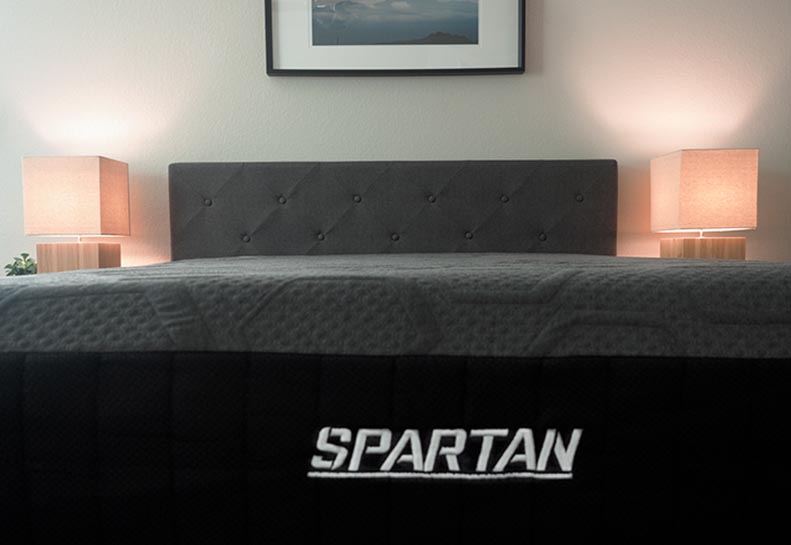
|
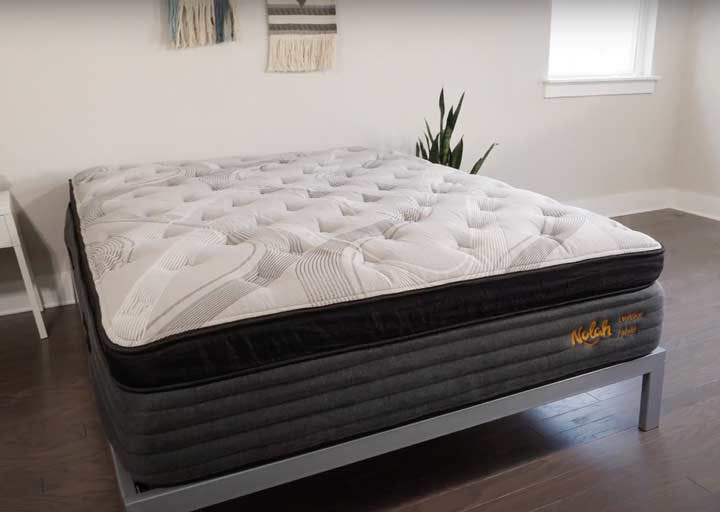
|
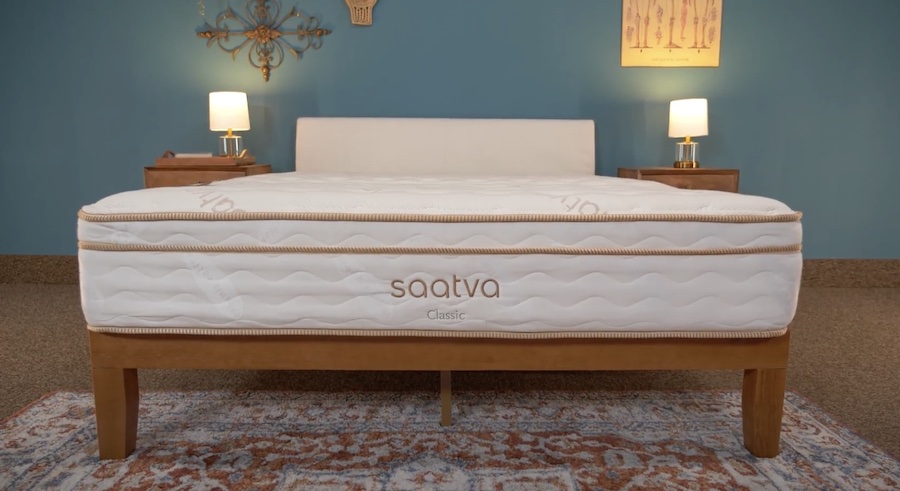
|
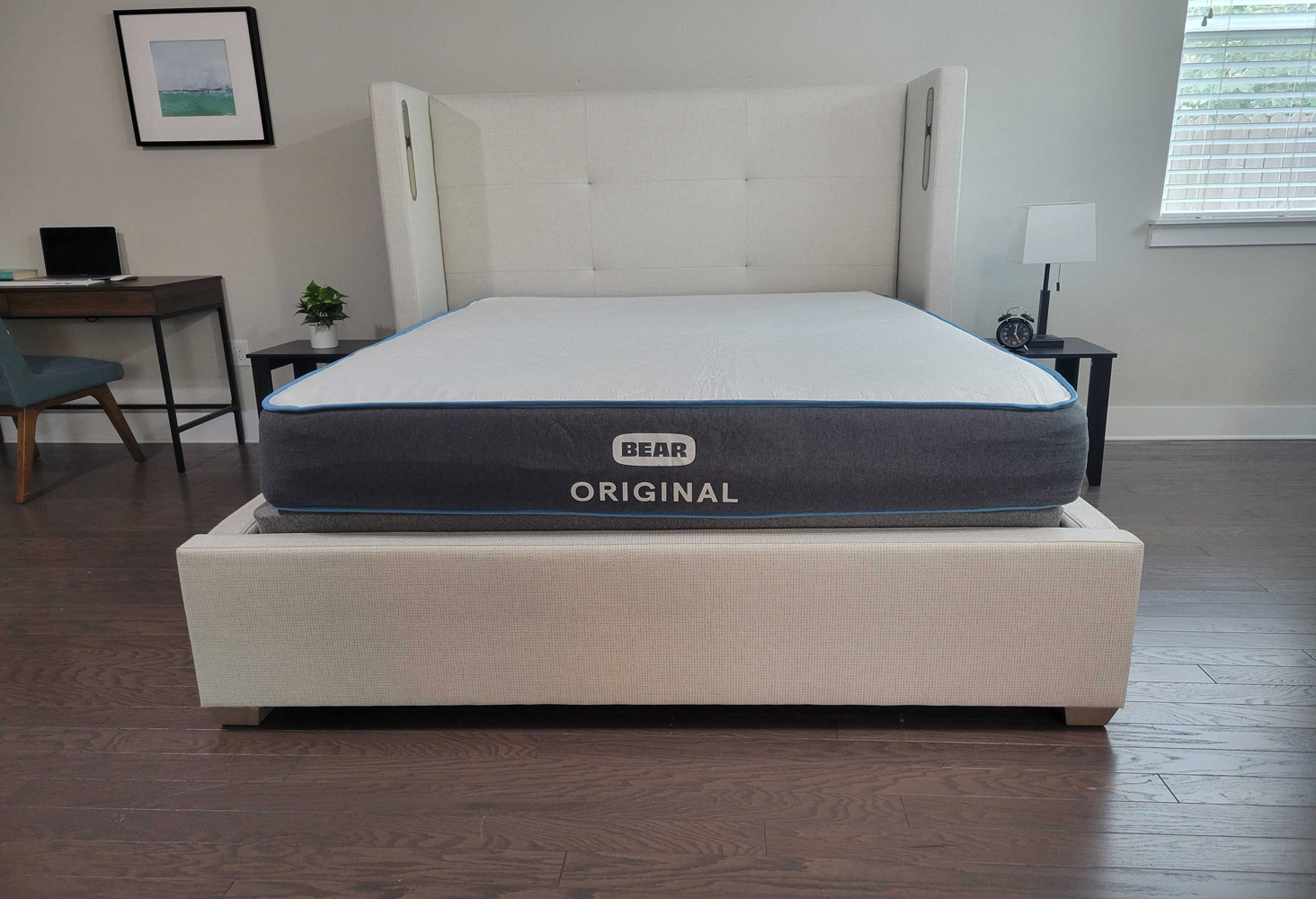
|
|
| Bear Elite Hybrid Mattress | Helix Midnight Mattress | Nectar Premier Copper Mattress | DreamCloud Original Mattress | WinkBed Plus Mattress | Brooklyn Bedding Spartan Hybrid Mattress | Nolah Evolution Hybrid Mattress | Saatva Mattress | Bear Original Mattress | |
| Rating | |||||||||
| Firmness | Medium-firm: 6/10 | Medium-firm: 6/10 | Medium: 5/10 | Medium-firm: 6.5/10 | Medium-firm: 6.5/10 | Multiple firmness options | Multiple firmness options | Multiple firmness options | Firm: 7/10 |
| Material | Hybrid | Hybrid | Foam | Hybrid | Hybrid | Hybrid | Hybrid | Innerspring | Foam |
| Cooling | — | — | — | ||||||
| Warranty | Lifetime Warranty | 10-year warranty | Lifetime warranty | Lifetime warranty | Lifetime warranty | 10-year warranty | Lifetime warranty | Lifetime warranty | Lifetime warranty |
| Shipping | Free shipping | Free shipping | Free shipping | Free shipping | Free shipping | Free shipping | Free shipping | Free white glove delivery | Free shipping |
| Trial Period | 120 nights | 100 nights | 365 nights | 365 nights | 120 nights | 120 nights | 120 nights | 365 nights | 120 nights |
| Best For | Back Sleepers, Stomach Sleepers, Hot Sleepers, Hip Pain, Seniors | Couples, Back Sleepers, Side Sleepers | Side Sleepers, Back Sleepers, Hot Sleepers, Hip Pain | Back Sleepers, Hot Sleepers, Seniors | Back Sleepers, Stomach Sleepers, Hot Sleepers | Joint Pain, Back Pain, Side Sleepers | Side Sleepers, Back Sleepers, Hip Pain, Seniors | Back Sleepers, Stomach Sleepers, Back Pain, Hot Sleepers, Seniors | Hot Sleepers, Back Sleepers, Side Sleepers, Hip Pain |
How We Chose the Best Mattress for Athletes
At Sleep Advisor, we physically bring mattresses into our studio and put them through a battery of in-person tests for categories such as edge support, pressure relief, and cooling. We also have multiple people lie on top of each bed so that we can know how they feel to different body types.
For this list, I paid the most attention to factors that are relevant to athletes who want to recuperate well at night. I tried to find beds that matched well with a mix of scenarios and sports, including ones that cradled commonly injured areas.
I also consulted several experts to help get an idea of what athletes need from their beds.
Lastly, I chatted with some of my athletic colleagues about what kind of beds they prefer and how sleep helps them perform better. They include:
- Caine Wilkes – 2020 Olympian and competitive weightlifter
- Kate Meier – Competitive weightlifter, certified weightlifting coach (USAW-L1), and certified personal trainer.
- Elizabeth Whaley – Current Wake Forest University track and field and cross country athlete
- Carter Coughlin – Former Wake Forest University cross country athlete, current elite competition runner
- Rachel Harris – Former collegiate soccer player
- Sosha Lewis – Competitive Master’s CrossFitter
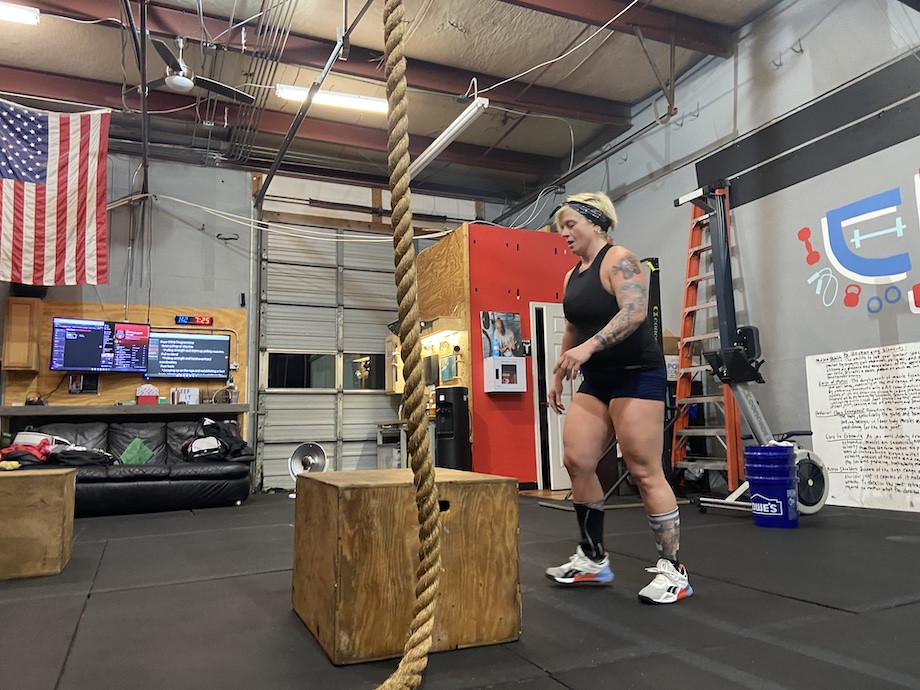
Components We Want to See in a Mattress for Athletes
Based on feedback from athletes themselves and our extensive knowledge of the mattress marketplace, we looked for the following traits in the mattresses we chose for this roundup:
Support Over Softness
Athletes need stable support and spinal alignment from their beds, lest they experience back pain in addition to the soreness from training.1 A sturdy innerspring unit or base foam should provide this bracing foundation, while comfort foams up top help with pressure relief.
Decent Cooling
No one wants to feel overheated at night, and athletes can run even hotter than the average person.2 A mattress with effective cooling components helps to stave off sweating and restlessness.
Enhancements that Target Sore Muscles
Some of the beds on the list below feature special textiles (e.g. Celliant®) that claim to promote muscle recovery via infrared energy. These technologies may boost your athletic routine nightly (though we should add the caveat that research on their efficacy is sparse).
Best Mattress for Athletes
Bear Elite Hybrid – Editor’s Pick

Bear Elite Hybrid Mattress

Product Details
Our Recommendation
Financing Options
Financing options are available for this mattress.
Why the Bear Elite Hybrid Earned Best Mattress for Athletes Overall
The word “athlete” covers a wide range of sports and specialists. To decide on a bed that could satisfy a large slice of the active world, I thought about mattresses that have a versatile feel, features that can help with pain relief, and a structure that suits most body types.
The Bear Elite Hybrid quickly rose to the top of the pack. It’s the most luxurious mattress made by a brand that already markets to athletes.
You can pick between a Firm, Medium, or Soft version of the hybrid. You can also choose to add a special ingredient to the cover (which already features phase change material for cooling): Celliant® fibers. According to Bear, by transforming body heat into infrared energy, Celliant® reportedly cuts down on inflammation and helps to oxygenate the body’s tissues, promoting muscle recovery.
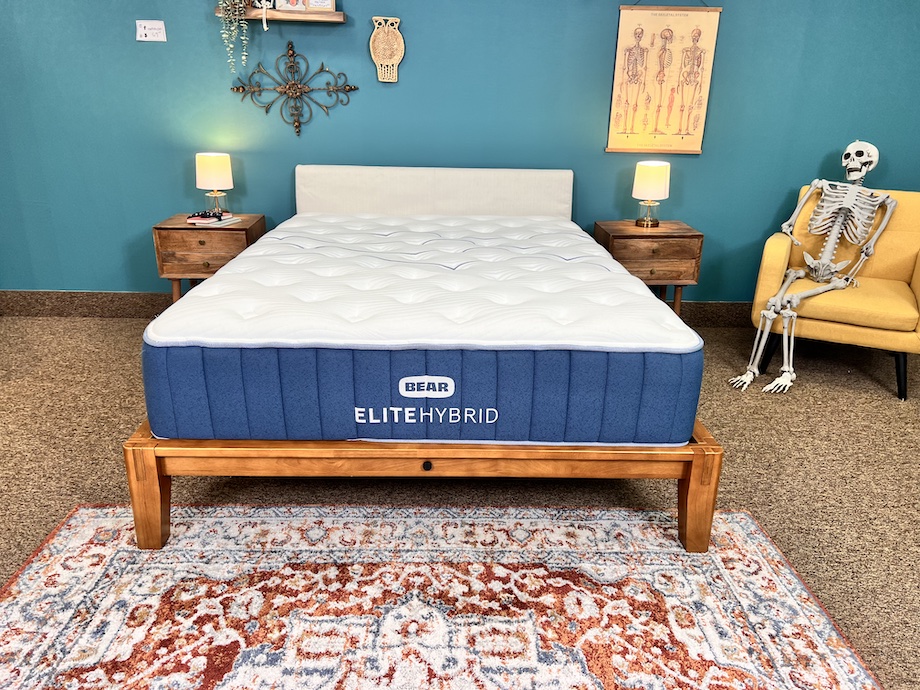
The individually wrapped coils have built-in lumbar support. I love this feature for athletes since they often experience a lot of wear and tear on their backs.
Helix Midnight – Best Mattress for Weightlifters

Helix Midnight Mattress

Product Details
Our Recommendation
Financing Options
Financing options are available for this mattress.
Why the Helix Midnight Earned Best Mattress for Weightlifters
Weightlifters need a mattress that readily supports their large muscle mass and facilitates muscle recovery. Because not every weightlifter has the same body type or comfort preferences, a bed with a versatile medium firmness and sturdy, hybrid construction is an ideal starting point for your mattress search. This is because a medium feel typically accommodates most people, and hybrids have the advantage of enhanced support from the coils and pressure relief from foam layers.
The Helix Midnight is a medium-firm hybrid at an affordable price point. Our testing team gave it perfect scores in support and pressure relief. We think it’s a well-balanced bed for weightlifters and athletes who specialize in strength training.
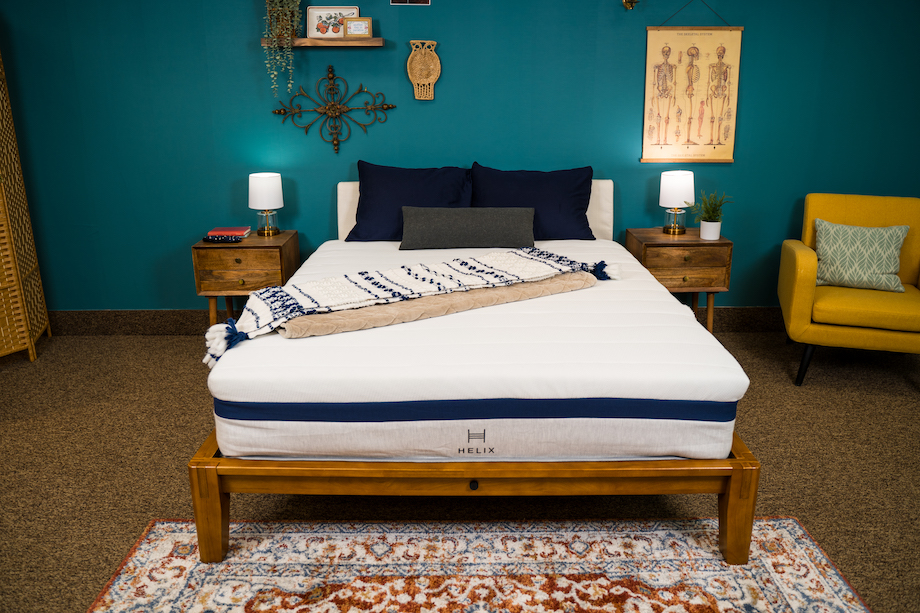
“I think competitive weightlifters are going to want something supportive after heavy lifting sessions, to help keep joints supported overnight,” said former Olympian and competitive weightlifter Caine Wilkes. “Since Olympic weightlifting and powerlifting are weight-class sports, though, I think smaller athletes would probably prefer a medium firmness instead.”
Nectar Premier Copper – Best Mattress for Athletes with Shoulder Pain
Editor’s Note: The Nectar Premier Copper mattress is no longer available. Our review of the brand’s newest model, the Nectar Luxe, is coming soon.

Nectar Premier Copper Mattress

Product Details
Our Recommendation
Financing Options
Financing options are available for this mattress.
Why the Nectar Premier Copper Earned Best Mattress for Athletes with Shoulder Pain
If you play tennis, baseball, or any sport with a lot of shoulder involvement, you’re probably no stranger to joint pain. You’ll want a mattress that can cradle these sensitive body parts without sacrificing a stable, supportive base.
The Nectar Premier Copper is an all-foam bed that welcomes your shoulders with a hug-like plushness and sink. However, its base layer is strong and dense—good for spinal alignment.
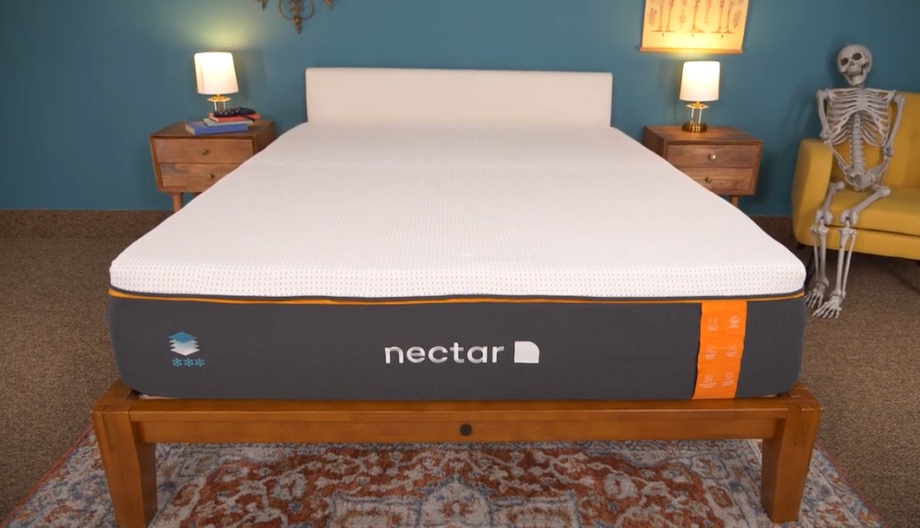
DreamCloud – Best Mattress for Runners

DreamCloud Original Mattress

Product Details
Our Recommendation
Financing Options
Financing options are available for this mattress.
Why the DreamCloud Earned Best Mattress for Runners
Runners place a lot of stress on their lower bodies. Your hips, legs, and feet can all experience soreness after a long run (and injuries to these areas can occur if you overtax yourself). A new mattress probably won’t shrink your average mile time, but it can ensure that you’re well-rested before your next race or practice.
“As a collegiate distance runner who trains at a high intensity year-round, recovery is equally important, if not more so, than my actual workouts. I make sure to prioritize quality sleep so that I can avoid injury, maximize the benefits of my training, and be optimally energized for practice and racing. Because of our energy-intensive training, my coach and trainers recommend around 70 hours of sleep a week, which is no small feat.” -Elizabeth Whaley, current Wake Forest University track and field and cross country athlete
When it comes to mattress shopping as a runner, support for your spine, hips, and legs should be paramount. Whaley looks for a firm mattress that keeps her hips elevated and her spine aligned. “If I sleep on too soft of a mattress, my hips sink, my back arches and I often wake up with discomfort and lower back pain.” Given her feedback, I recommend the DreamCloud for runners; it’s a medium-firm hybrid mattress with lots of spine-aligning lift.
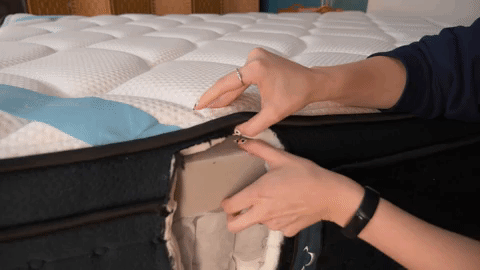
WinkBed Plus – Best Mattress for Plus-Size Athletes

WinkBed Plus Mattress

Product Details
Our Recommendation
Financing Options
Financing options are available for this mattress.
Why the WinkBed Plus Earned Best Mattress for Plus-Size Athletes
Plus-size and heavyweight athletes need a bed that will reliably support them without sagging. The WinkBed Plus was made for sleepers who weigh more than 250 pounds and is one of the first mattresses designed specifically for larger bodies.
The WinkBed Plus provides an excellent combination of pressure relief and support that should be appealing to plus-size athletes. They may also enjoy its multiple cooling elements, strong edges, and zoned coils.
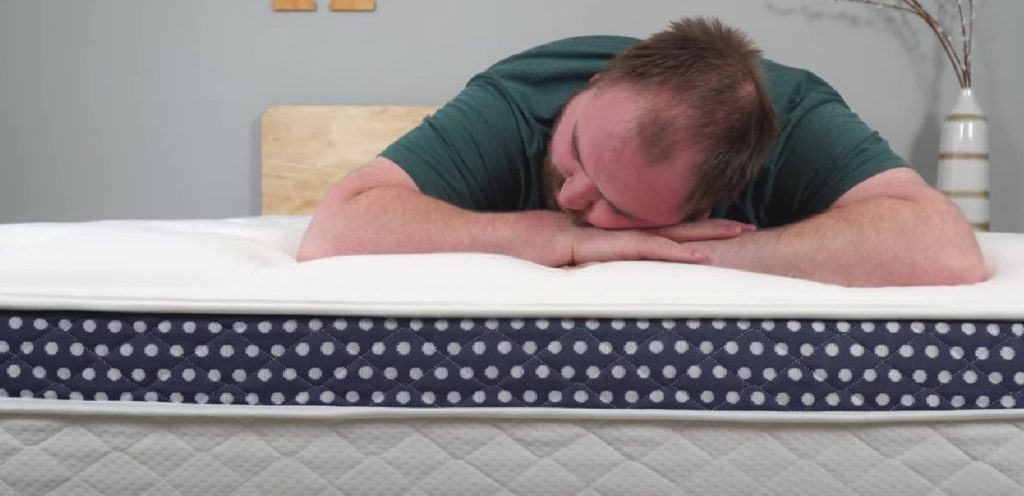
Brooklyn Bedding Spartan – Best Mattress for Muscle Recovery

Brooklyn Bedding Spartan Hybrid Mattress

Product Details
Our Recommendation
Financing Options
Financing options are available for this mattress.
Why the Brooklyn Bedding Spartan Earned Best Mattress for Muscle Recovery
Athletes looking to rest their hardworking muscles may need more from their mattress than the standard foams and fabrics. Luckily, the Brooklyn Bedding Spartan has a trick up its sleeve—or, more precisely, in its cover.
The cover’s fibers boast far infrared ray (FIR) technology. According to the brand, this technology can shift your body heat into infrared energy, which in turn boosts blood flow and aids muscle recovery as you sleep. To complement this feature, the foam just below the cover is infused with a phase change material, which helps to cool you off if you’re running warm.
Nolah Evolution – Best Cooling Mattress for Athletes

Nolah Evolution Hybrid Mattress

Product Details
Our Recommendation
Financing Options
Financing options are available for this mattress.
Why the Nolah Evolution Earned Best Cooling Mattress for Athletes
If you’re an athlete who spends a lot of time sweating, you’d probably prefer to stay cool and dry in bed. Unfortunately, feeling overheated at night is a common problem, and it can drastically reduce the quality of your sleep.
To combat it, you might consider the Nolah Evolution. This hybrid mattress stands an imperial 15 inches high, and many of those inches are dedicated to cooling components. It even has a specialized gusset that surrounds the top 4 inches of the bed and vents out excess heat.
I timed how quickly the bed could cool off after I had rested on it for five minutes, and it only took two minutes to regain its starting temperature (a refreshing 68 degrees). This efficiency earned it a perfect 5 out of 5 from me in the cooling category.
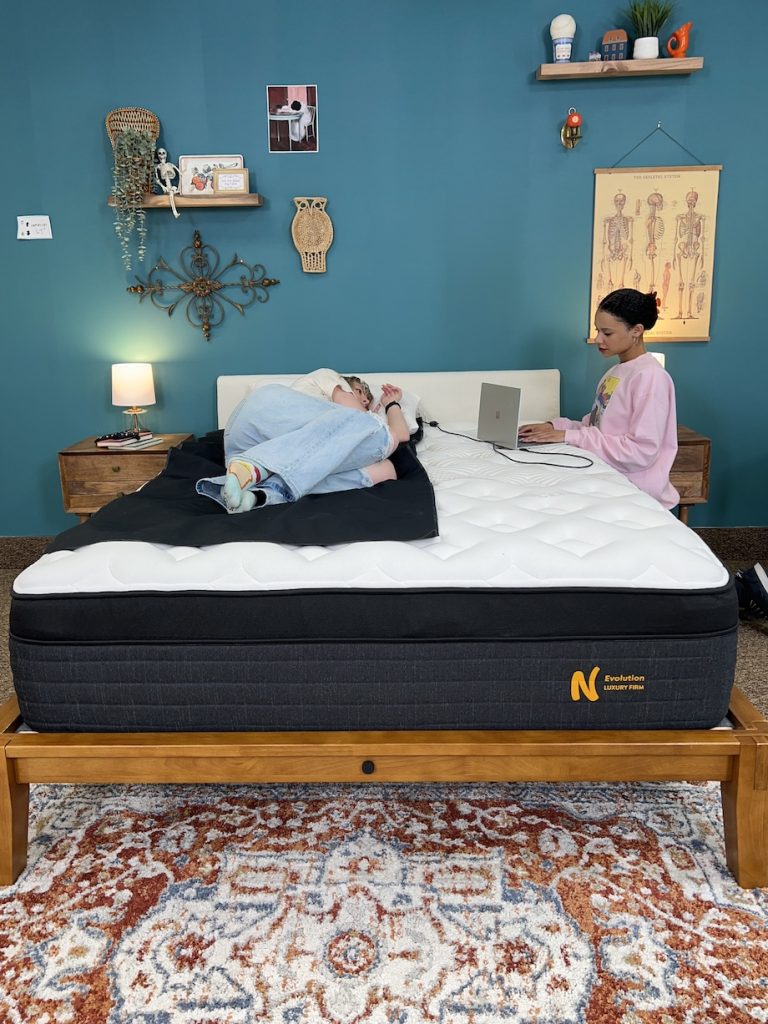
Saatva Classic – Best Mattress for Athletes with Back Pain

Saatva Mattress

Product Details
Our Recommendation
Financing Options
Financing options are available for this mattress.
Why the Saatva Classic Earned Best Mattress for Athletes with Back Pain
Whether it’s from twisting, lifting, or getting tackled, back pain is a common and aggravating problem for athletes and active folks. If your mattress doesn’t have enough active support to fill the gap between your lower back and the bed, this pain can be even more severe. Enter the Saatva Classic: a bed with two innerspring systems that leads the pack in lumbar support.
The Saatva Classic perfectly lifted my midsection when I was on my back and stomach. Other team members were impressed by how the lumbar support eased their back pain.
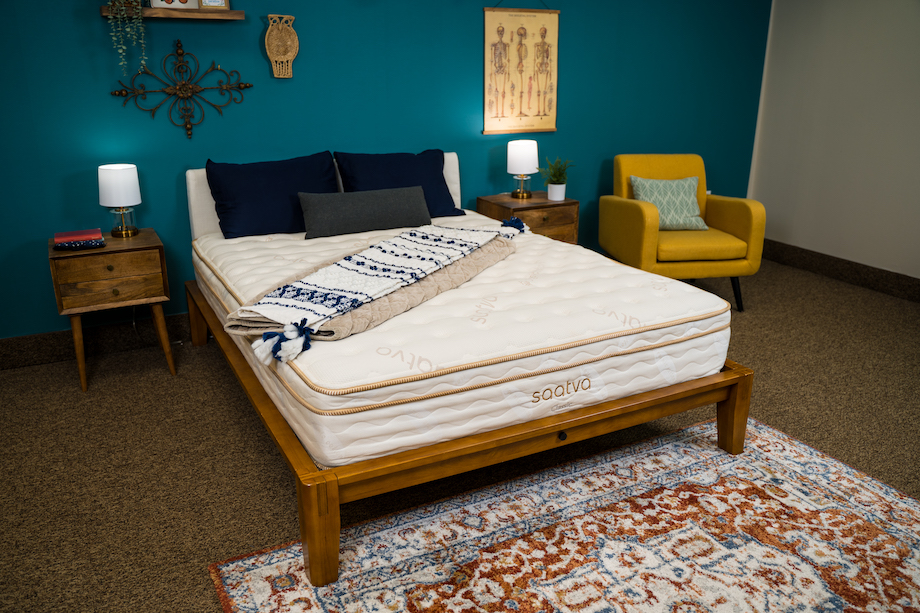
Bear Original – Best Firm Mattress for Athletes

Bear Original Mattress

Product Details
Our Recommendation
Financing Options
Financing options are available for this mattress.
Why the Bear Original Earned Best Firm Mattress for Athletes
A firm mattress puts support first, sacrificing plushness for more pronounced spinal alignment and lift. If you’re an athlete who doesn’t mind a less-than-pillowy bed, then you may benefit from a firm model like the Bear Original—it should keep your back and hips from dipping too low and exacerbating any pain or soreness.
Although this bed is made entirely of foam, it’s firmer than most all-foam beds, which is great news for folks who like an all-foam bed but still want something more solid.
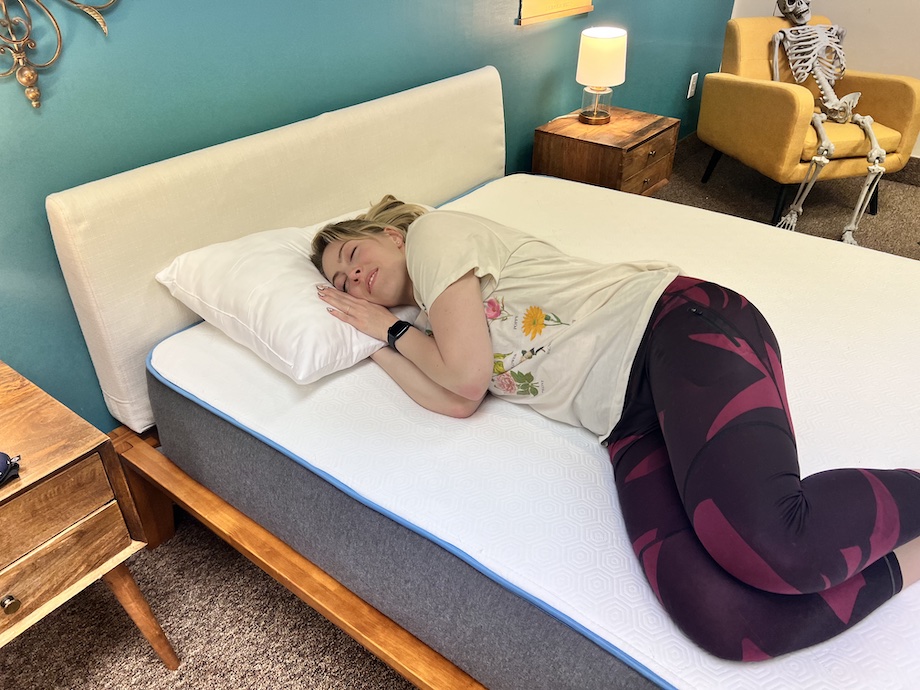
Sleep Advice from Accomplished Athletes
“I sleep pretty evenly between my back and side, so I prefer [a bed] that’ll provide overall support on my back, hips, or shoulders. I prefer a firm mattress because I want that support, especially because I’m a bigger athlete; I’ll sink a little too much on anything softer.”
— Caine Wilkes, 2020 Olympian, 3-time Pan American Weightlifting Championships Gold Medalist
“My number one priority for recovery when choosing a mattress is comfort because if I’m not comfortable, I won’t sleep well. Next is firmness because anything softer than a medium firmness won’t support my back. On the flip side, a mattress that’s too firm gives me shoulder pain, which inhibits my ability to lift weights or perform exercises that use my shoulders, neck, and back.”
— Rachael Harris, former member of the Northwest University soccer team.
“Sleep is the most important (and cheapest) recovery tool available, and finding the mattress that helps you get the best sleep is vital.”
— Kate Meir, USA Weightlifting Level 1 Coach
“I absolutely think a comfortable bed can help you recover. Not only can it help you get better sleep, but it can also provide support for your muscles to relax and heal overnight. Two birds, one stone.”
— Carter Coughlin, former Wake Forest University cross-country runner.
How to Choose the Best Mattress for Athletic Performance
As an athlete, you’ll want a mattress that helps you recuperate and feel refreshed for your next game, workout, race, or movement of choice. Look through the considerations below as you search for your next bed, and read on to learn how to get quality sleep that can boost your athletic performance.
Support
Finding the right amount of mattress support is crucial for athletes. However, support isn’t a one-stop shot, as it will vary depending on an athlete’s body type, sleep position, and even any injuries that they may be dealing with. Athletes will want to look for a mattress that is solidly built and provides excellent spinal alignment and lumbar support.
We look at how a bed provides support in each sleeping position: side, back, and stomach. Do we feel like we’re sinking into the mattress too much or do we feel comfortably lifted? If we feel lifted, that tells us the bed is supportive.
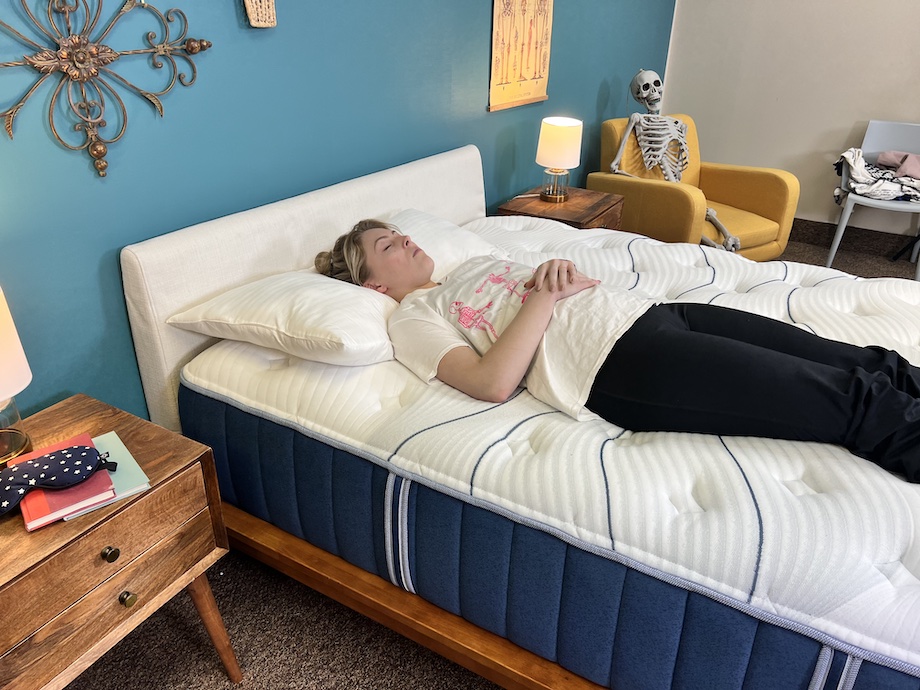
Cooling Elements
A good cool-down isn’t just an essential phase of your workout—it’s also important for getting restful sleep. One of my biggest sleep issues during my playing days was how hot I would get at night, and apparently, I am not alone in this. Many elite and sub-elite athletes attribute poor sleep quality to feeling too hot while in bed.3
Staying at a comfortable temperature at night is easier when your mattress has effective cooling elements. Keep an eye out for phase change material—a fancy term for a substance that absorbs and releases heat as the molecules inside it shift between solid and liquid—and other heat-dissipating or breathable fabrics, such as cotton or Tencel™.
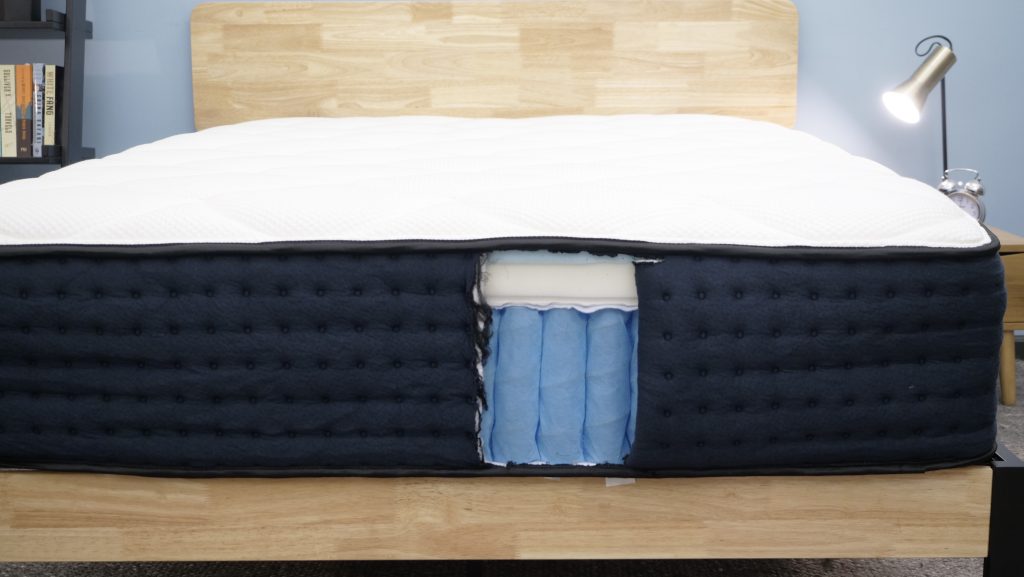
Mattress type also plays a role in cooling. Typically, memory foam mattresses are going to retain the most heat, whereas a bed with latex and/or springs will allow for cooling airflow.
Mattress Enhancements
A few mattresses we featured above have special fibers in their construction that allegedly promote muscle recovery, such as Celliant®. This textile reportedly converts body heat into infrared energy to increase blood flow, decrease inflammation, and generally help your body recuperate after a workout.
The hard science on these technologies is lacking, as the studies on their efficacy are few and have small sample sizes. But some athletes say that they make a difference, and we encourage you to try these beds to see for yourself if the performance textiles work for you.
“At this point, I would say Celliant® fiber is a ‘nice to have’ feature, but definitely not necessary. The mechanism of action is that our body heat is able to activate the ceramic particles (quartz, silicon oxide, titanium oxide) embedded in the Celiant fabric, which then remit the heat energy as far-infrared radiation. Based on the clinical studies, this does seem to affect the oxygenation of the areas of the body that are in contact with the Celliant® fiber.4, 5 Higher oxygenation levels may help improve the cell renewal rate in the body and enhance recovery.6
“So, for those high-level athletes seeking to optimize every facet of their lives, then I would suggest going for the options with Celliant® fiber or possibly getting Celliant® bed sheets with the hopes of seeing some marginal benefits. However, it’s likely not necessary for the average athlete (depending on the added expense).”
– Pete Nastasi, CNC, CPT
Your Sports or Athletic Goals
The demands on your body will depend on your preferred sport or form of exercise, and your mattress should pair well with your goals. For example, if you’re trying to bulk up and lift heavier, you’ll want a bed with a high weight capacity; if you’re focusing on your hips and legs as you train for a marathon, you’ll want plenty of lumbar support.
If you have a trainer, they’ll be a wonderful resource as you set goals for yourself and map them onto your mattress. Decide what’s most important to you as you hone your skills, and then look for beds that seem to address these priorities.
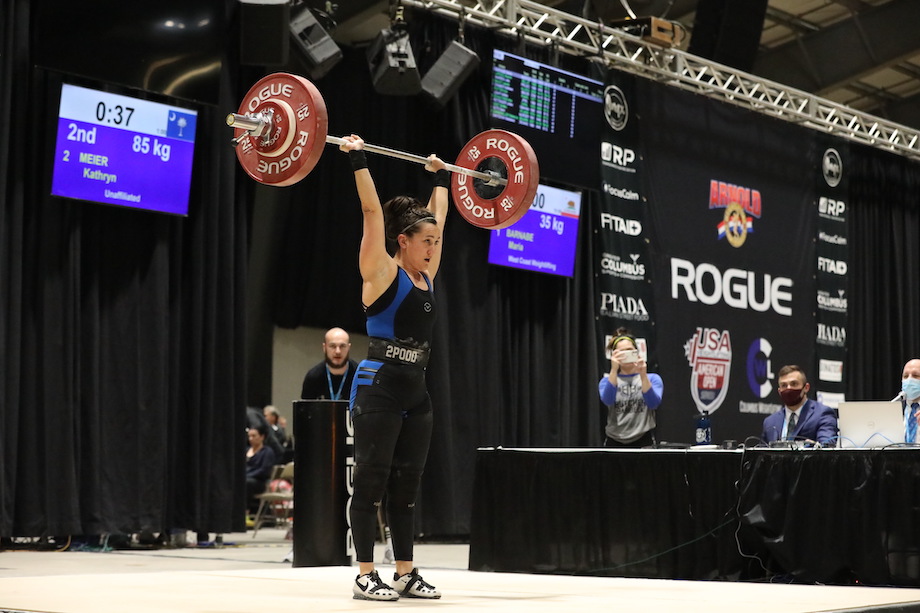
Sports Injuries
If you play a high-impact sport, or if any of your athletic pursuits leave you open to injuries (acute or chronic), you’ll want a mattress that doesn’t make things worse.
Look at beds that have enough pressure relief, as athletes’ joints are particularly vulnerable. In fact, in a study published in 2022, one in four former Olympic athletes was later diagnosed with osteoarthritis.7
It’s not just elite, professional athletes who experience joint pain, either; athletes of all ages can experience joint pain and injury, particularly those who play high-impact sports or do high-impact workouts.8
This is where a mattress with good pressure relief can come in. Pressure-relieving materials such as memory foam and latex foam will gently cradle the joints and other sensitive zones of the body, reducing tension and potentially offsetting pain in those areas.
The height of the bed might also make a difference, as it’s easier to get in and out of beds more suited to your height (especially if your mobility is compromised).
Finally, you may want to look into adjustable bed frames. These allow you to raise your head and feet into a variety of postures and can be useful for elevating injured limbs.
Read More: Best Mattresses for Pressure Relief
Your Weight and Body Type
Depending on your sport, your body weight may have a bearing on your athletic performance, and might even be used as a metric for sorting you into a certain competitive class. For some athletes, such as football players, basketball players, and weightlifters, being larger or taller can have its advantages.
Your weight also affects your perception of your mattress’s firmness level. The “average” body type feels just peachy on the best medium-firm mattresses. (That’s any bed that falls between a 5 and a 7 on our firmness scale). However, heavier athletes may need more support in the form of a firm mattress, and lightweight ones, such as people under 130 pounds, will feel better atop a plush mattress.
Additionally, heavyweight athletes may need stronger support materials, such as springs, whereas average- and lightweight folks may feel supported enough on an all-foam bed. (If you’re a larger athlete in need of a bed that will support you without sagging, check out our list of the best beds for heavy people.)
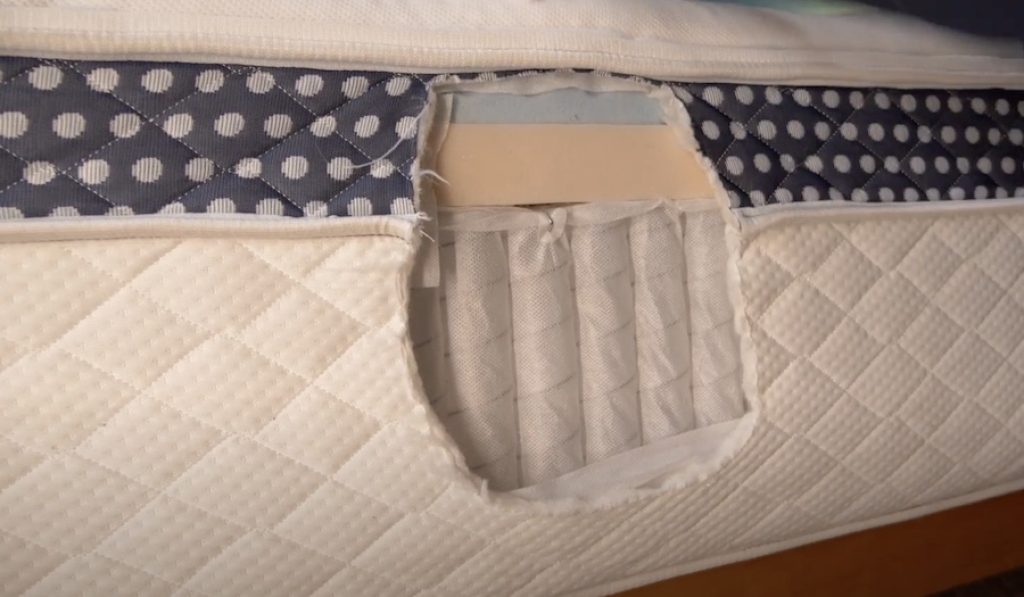
No matter what you weigh, you’ll want your spine to feel neutral and well-aligned when you lie down. If you feel like parts of your body are too elevated or too sunken, and that your weight is being distributed unevenly, you should look for a different bed.
Mattress Type
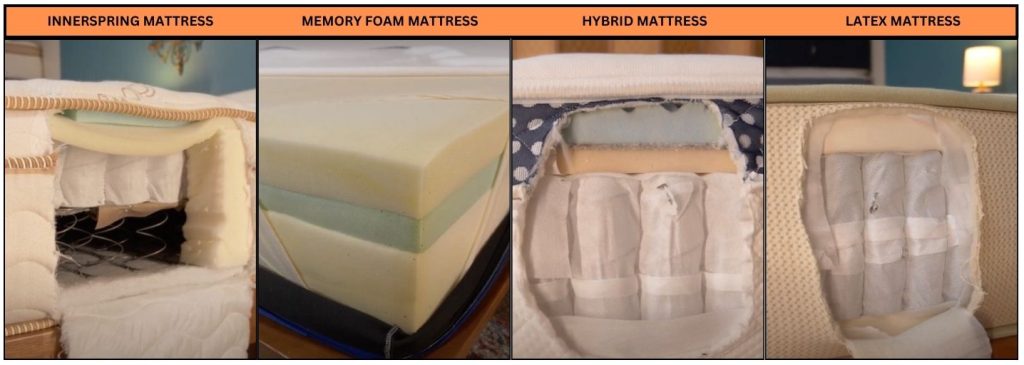
Innerspring Mattresses
Innerspring mattresses have a thin comfort layer on top of a primary layer of steel innerspring coils. They feel bouncy and supportive, but they don’t have a lot of cushion.
Innerspring beds tend to sleep cooler than beds that include memory foam, which can be a plus for athletes who work up a sweat during the day. They’re also reliable when it comes to preserving healthy spinal alignment.
On the other hand, they don’t offer much pressure relief for sore muscles and joints, because they lack the thicker comfort foams of other mattress types.
See our picks for the best innerspring mattresses.
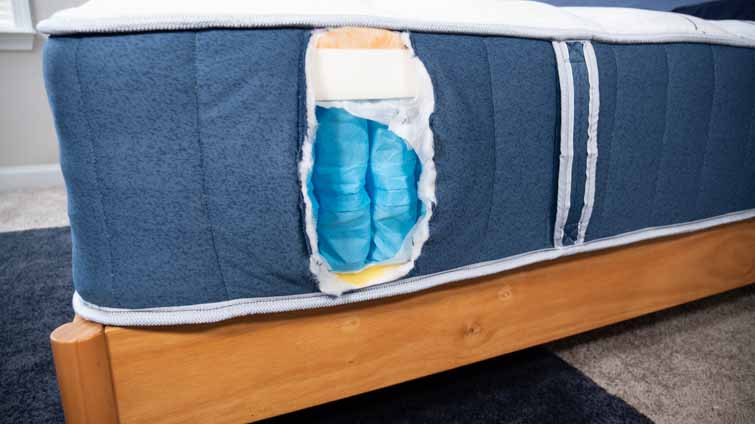
Hybrid Mattresses
Hybrid mattresses include a layer of innerspring coils as well as several comfort layers on top. They combine the benefits of traditional innerspring mattresses and all-foam mattresses so they can both support the spine and relieve pressure on the joints. This combination makes them a great pick for athletes of any stripe.
“I like a hybrid mattress because memory foam feels most comfortable to me, but innerspring provides the most support,” Coughlin said.
Browse the best hybrid mattresses.
Memory Foam Mattresses
When you lie down on a memory foam mattress, you can expect to sink into the bed to some degree. You might feel a “deep hug” from the foam or more of a gentle cradling sensation. Memory foam can help reduce soreness and pressure buildup for athletes with joint pain or certain injuries.
However, memory foam tends to trap heat. It can also feel less supportive for athletes who weigh more than 230 pounds or so. If that’s you, but you’re still set on a mattress with memory foam in its construction, we’d recommend a hybrid that contains memory foam in its comfort layers.
See our recommendations for the top memory foam mattresses.
Latex Mattresses
Natural latex foam is made from the sap of rubber trees. It’s a breathable, cool, and bouncy material with more eco-friendly credentials than synthetic foams. It’s also quite durable, and should last you for several years—a big benefit if you’re an athlete who wants a long-lasting bed that won’t sag.
Although it provides a nice balance of support and pressure relief, it doesn’t have the same “sinking” feel of memory foam, and some people don’t like its springiness. It’s also one of the priciest mattress materials on the market today.
Read through our list of the best latex mattresses.
Your Sleeping Position
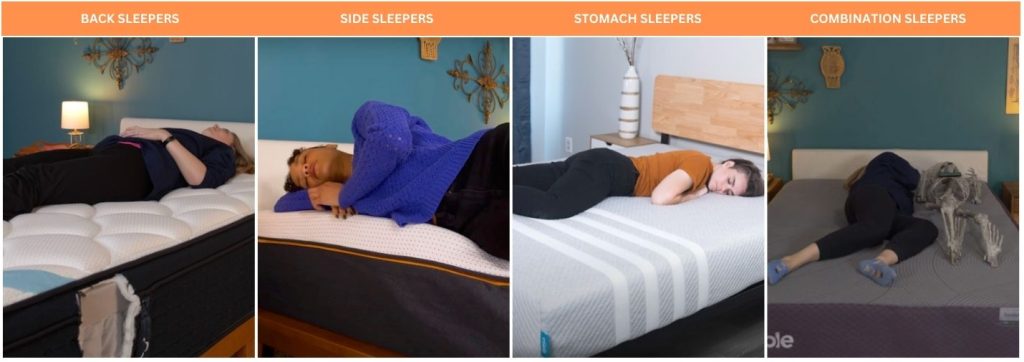
If you consistently sleep on your side, you’ll want a mattress that feels softer and relieves pressure around your shoulders and hips. If your mattress is too unyielding, it’ll create tension in these “sharper” areas – a big problem for athletes.
If you sleep on your back, you’ll want a bed that isn’t too soft and isn’t too firm. A medium-firm bed helps the spine to stay in neutral alignment through the night, staving off lower back pain.
If you sleep on your stomach, your mattress will need to be pretty firm. A firmer, more supportive construction keeps the hips from dipping so low that your spine falls out of its ideal alignment.
Budget
Deciding how much to spend on a new mattress can be a fraught process. But if you’re an athlete, a quality bed is extremely important—your investment in your sleep can be directly reflected in your energy levels and performance during the day.
While ultra-budget beds can be very cheap upfront, they often aren’t as durable or well-made, so don’t just go for the lowest price you find. Typically, innerspring mattresses and all-foam beds are less expensive, whereas hybrids and latex mattresses cost more.
Additionally, some eco-friendly models may run higher in price as they incorporate more natural and organic materials.
If you shop during key holidays or when deals are active, you can often save hundreds of dollars on your new bed. Shopping online also allows you to access high-end mattresses at lower prices than you’d see in stores because they’re sold directly from the manufacturer.
Anything Else that Helps You Achieve Restful Sleep
We’ve covered some of the key considerations for athletes in need of a new mattress, but you’re the true expert on your sleep and comfort needs. There are many more aspects that can make a mattress feel awesome—or awful.
For example, if you’re a light sleeper, you’ll want a bed that isolates motion well, and if you spread out a lot during the night, then edge support will be an important factor.
Finally, some mattress features will benefit any sport or exercise. Always look for a bed that encourages your spine to rest in its natural, neutral curvature, with no uncomfortable or uneven spots. Good spinal alignment is important for preventing back pain, regardless of whether you’re an athlete or not.9
Advice from a Medical Expert
We also reached out to Dr. Raj Dasgupta, who has over 20 years of experience in the medical field, to see his thoughts on what key qualities athletes need in a mattress.
“Athletes need a mattress that supports their body, relieves pressure, stays cool, lasts long, minimizes motion transfer, and feels right in terms of personal firmness preferences to help them recover and perform their best.”
How Can a Mattress Help with Athletic Performance?
A mattress that works well for your body will enhance the quality of your sleep, which in turn helps with your recovery after exercise, your athletic performance the next day, and your overall health. “Sleep is very important to me as a strength athlete, mostly because it’s the simplest and easiest way to help recover from daily training, and it probably helps the most, too,” said Caine Wilkes.
When we sleep, we go through two sleep phases: non-REM and REM sleep. During non-REM sleep, your body builds bone and muscle, repairs tissues, and strengthens your immune system.10 Therefore, a good mattress can improve your sleep quality and your body’s ability to recuperate.
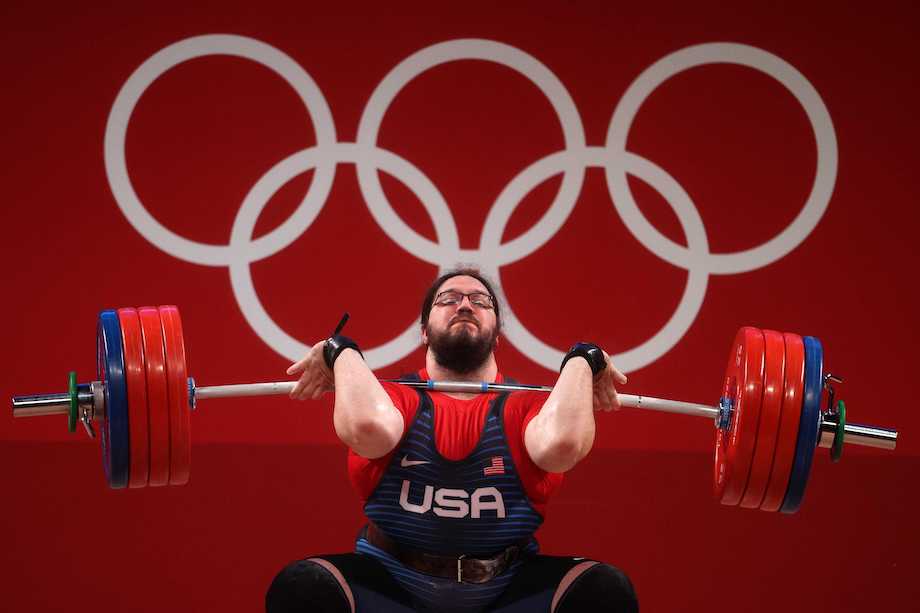
Athletes, in particular, stand to gain a lot from improving their sleep hygiene. Increasing the time you spend sleeping has been shown to have a positive effect on multiple athletic skills, from the accuracy of a tennis serve or basketball free throw to the efficiency of kicks while swimming.
On the other hand, sleep deprivation can drastically hinder your physical and mental performance. It affects your reaction time, endurance, and many other faculties essential to athleticism.11
What Causes Sleep Problems in Athletes?
It’s common for athletes to experience more disturbed sleep – especially elite or professional athletes.3
At the same time, though, athletes actually need more sleep than an average person for multiple reasons, including muscle recovery, carbohydrate metabolism, appetite, food intake, protein synthesis, and even the kind of fast, reflexive thinking that enables you to catch a quick pass.12
Some of the external factors that can cause sleep problems in athletes include competition schedules, travel, stress, academic demands (in student athletes), and overtraining.12
There is research that suggests overtraining is linked to worse sleep, and doing an intense workout one hour before bed has been shown to decrease sleep quality.13, 14
Learn more: Sleep and Exercise – How Timing These Two Can Improve Your Health
Sleep Apnea in Athletes
Multiple athletes and celebrities, including Shaquille O’Neal, have spoken about their experience with sleep apnea. This condition can become dangerous if left untreated, as it disrupts your breathing during sleep. It can also negatively affect your athletic performance.
“A few years ago I took a sleep test, found out I had sleep apnea, and have been using an APAP ever since,” said Caine Wilkes. APAP stands for Automatic Positive Airway Pressure device, a machine that helps to keep your airway open during sleep.
Once he began using an APAP at night, Wilkes got more and better sleep, the benefits of which extended to his weightlifting. “While my lifts didn’t suddenly jump up 10 kilograms or anything like that, I did notice an immediate difference in that I could stay focused during my training sessions and came just a bit more energized.”
How To Get Better Sleep as an Athlete
Make Sleep a Part of Your Athletic Practice
- Develop a regular sleep schedule – Going to bed and waking up at the same time each night and morning can do wonders for your body and energy levels. If you’re an athlete, sleep is especially vital to your recovery, so we recommend trying to nail down a sleep routine.
- Get outside as early as you can – While we’re on the subject of sleep schedules, you should know that exposing yourself to morning sunlight when you start your day is a simple hack for resetting your circadian rhythm. A morning walk is a great way to get sunlight exposure while staying active.
- Take a rest day – Overtraining can lead to sleep disturbances.15 Experts recommend that you rest a minimum of one day per seven to 10 days, though many athletes who engage in high-intensity exercise will need more.16
Wind Down Before Bed
- Make your room like a cave – Keep your bedroom dark, quiet, and cool, much like a cave. This is the best environment for getting a good night’s sleep. If you live in a noisy area, a white noise machine could help tamp down auditory distractions.
- Don’t work out one hour before bed – Research from Harvard Health tells us that high-intensity exercise just before bed can negatively impact sleep quality.14 Move your training to earlier in the day, and do some gentle stretching at night instead.
- Take magnesium before bed – Magnesium is touted as “nature’s calming agent” for its ability to reduce anxiety and insomnia in many people. Luckily for athletes, research shows it’s also great for muscle recovery.17 We’ve compiled some of the best magnesium supplements for sleep to help you integrate it into your nightly routine.
Adjust Your Diet to Improve Your Sleep
- Eat more complex carbs – Favor complex carbs (like whole grains or sweet potatoes) over simple carbs (like bread or pasta). Complex carbs raise serotonin levels and lower cortisol levels, which can help you sleep.18
- Make sure you’re getting enough calories – Athletes need more calories than the average person because they burn more calories on a daily basis. If you’re training too strenuously without keeping pace with your food intake, you may also start sweating a lot at night due to low blood sugar.19 It’s recommended that competitive endurance athletes eat anywhere from 3,000 to 5,000 calories per day.20
- Reduce your intake of caffeine and alcohol – Studies show that consuming caffeine up to six hours before bedtime can negatively impact your sleep.21 Likewise, consuming alcohol can not only negatively impact your sleep quality, but it can also inhibit your athletic performance. 22, 23
Try Additional Recovery Techniques
- Practice meditation before bed – If you’re experiencing anxiety or stress, falling asleep is often difficult. Meditating before bed is one way to calm your mind in preparation for better sleep.
- Treat your muscles to a cold plunge – Many athletes swear by the positive effects of cold plunges on their recovery and performance. A dip in body temperature near bedtime can also prime you for sleep, so these watery therapies are doing double duty. Read up on the best cold plunge tubs if you’re curious about adding one to your home.
- Sit in a sauna – A session in a home sauna can relax your muscles as well as your mind. These heated spaces have myriad potential benefits, from easing soreness to facilitating sleep, though the extent of their effects is still being studied.
- Stretch – Stretching before bed can help you wind down. However, the benefits extend beyond this since regular stretching can keep the muscles flexible and reduce the risk of strain or injury.24
Best Mattress for Athletes FAQs
What type of mattress is best for athletes?
A hybrid mattress often represents the best ratio of pressure relief to support for athletes.
In general, an athlete’s mattress should be supportive for the spine, pressure-relieving on the joints, and pleasantly cool. Finding a mattress with zoned support can also be beneficial, as it provides specialized degrees of resistance to different parts of the body (such as the lower back).
What mattresses do pro athletes use?
Professional athletes often use custom-designed mattresses that have been built to suit their bodies. They may also use a certain mattress brand that’s partnered with their sports organization. Sleep Number, for example, is an official partner of the NFL, and many pro football players use Sleep Number beds in their homes.
Otherwise, just like the general public, pro athletes can use their own discretion when shopping for a mattress—though they probably have a larger budget than most! If you’re looking for a more affordable option, check out our recommendations for Sleep Number alternatives.
Are firm mattresses better for athletes?
A firm mattress will definitely be better for an athlete than a very soft one, which could lead to uneven support and poor spinal alignment.
However, comfort should always be a factor in selecting your mattress, so we suggest aiming for a good balance of supportive firmness and pressure-relieving cushion. Hybrid mattresses often have softer foams at the surface paired with a strong innerspring unit at the base, and this combination works well for many athletes.
What’s the best sleeping position for athletes?
Back sleeping is recommended as the best sleeping position for athletes (and for most people), especially if you have any shoulder, hip, back, or joint issues.15
In this position, your spine should be straight and well-supported, and your pillow should be just low enough to keep the natural curvature of your spine – just as it would be when standing up straight. Another variation is the hook lying position, which is when you’re on your back with your knees bent and your feet flat.
Back sleeping can also allow your hip flexors and core to straighten and relax, which are often trouble areas for runners and lifters.
The only real downside to back sleeping is it can increase snoring and sleep apnea, as well as acid reflux. If you deal with any of these, side sleeping is a good second choice for athletes.
We don’t recommend stomach sleeping if you can help it. It can create tension and pain in the neck and back, which certainly won’t help your athletic performance.
What mattress doesn’t make you sweat?
Mattresses that contain coils and advanced cooling foams will sleep the coolest and help to prevent sweating the most. Latex foam and breathable covers can also regulate temperature.
That being said, it’s always good to read reviews before buying to see how effective a certain mattress is at cooling.
Final Breakdown: The Best Beds for Athletes
| Mattress | Best For | Price (Queen Size) | Review |
| Bear Elite Hybrid | Editor’s Pick | $2,305 | Bear Elite Hybrid Mattress Review |
| Helix Midnight | Weightlifters | $1,332 | Helix Midnight Mattress Review |
| Nectar Premier Copper | Athletes with Shoulder Pain | $1,949 | Nectar Premier Copper Mattress Review |
| DreamCloud | Runners | $1,483 | DreamCloud Mattress Review |
| WinkBed Plus | Plus-Size Athletes | $1,999 | WinkBed Plus Mattress Review |
| Brooklyn Bedding Spartan | Muscle Recovery | $1,999 | Spartan Mattress Review |
| Nolah Evolution | Cooling | $2,499 | Nolah Evolution Mattress Review |
| Saatva Classic | Athletes with Back Pain | $2,095 | Saatva Classic Mattress Review |
| Bear Original | Firm | $998 | Bear Original Mattress Review |

Julia Forbes
Sleep Advisor Mattress Tester
About Author
Julia is a product tester at Sleep Advisor, specializing in testing out mattresses and sleep accessories – she’s in the right line of work, because she loves to sleep.
Stomach Sleeper
Education & Credentials
- Certified Sleep Science Coach
References:
- Du, Shu-Hao., et al. “Spinal posture assessment and low back pain”. EFORT Open Reviews. 2023.
- Singh, Gurpreet., et al. “Core body temperature responses during competitive sporting events: A narrative review”. Biology of Sport. 2023.
- Doherty, Rónán., et al. “The Sleep and Recovery Practices of Athletes”. Nutrients. 2021.
- Athonvarangkul, Diana., et al. “Improved extremity tissue oxygenation with short-term exposure to textiles embedded with far infrared light emitting thermoactive particles in patients with diabetes mellitus”. Diabetes and Vascular Disease Research. 2023.
- Gordan, Ian L., et al. “Effect of Shirts with 42% Celliant™ Fiber on tcPO2 Levels and Grip Strength in Healthy Subjects: A Placebo-controlled Clinical Trial”. National Library of Medicine. 2019.
- Chen, Trevor C., et al., Effects of far-infrared radiation lamp therapy on recovery from muscle damage induced by eccentric exercise”. National Library of Medicine. 2023.
- “Elite sport linked with osteoarthritis risk”. University of Edinburgh. 2022.
- Amoako, Adae O., Pujalte, George Guntar A. “Osteoarthritis in young, active, and athletic individuals”. Clinical Medicine Insights: Arthritis and Musculoskeletal Disorders. 2014.
- “Improve Posture & Alignment for Your Spine”. National Spine Health Foundation. 2020.
- “Sleep.” Cleveland Clinic. Last modified June 19, 2023.
- Vitale, Kenneth., et al. “Sleep Hygiene for Optimizing Recovery in Athletes: Review and Recommendations”. National Library of Medicine. 2019.
- Halson, Shona. “Sleep and Athletes”. Gatorade Sports Science Institute. 2017.
- Cho, Unjung., Im KyoungBin. “Adolescent athletes’ sleep problems and overtraining: A case study”. Sports Psychiatry: Journal of Sports and Exercise Psychiatry. 2024.
- “Does exercising at night affect sleep?”. Harvard Health Publishing. 2024.
- Lastella, Michele., et al. “Can Sleep Be Used as an Indicator of Overreaching and Overtraining in Athletes?”. Frontiers in Physiology. 2018.
- Ansorge, Rick. “Rest and recovery are critical for an athlete’s physiological and psychological well-being”. UCHealth Today. 2022.
- Córdova, Alfredo., et al. “Impact of Magnesium Supplementation in Muscle Damage of Professional Cyclists Competing in a Stage Race”. Nutrients. 2019.
- Nisar, Maheen., et al. “Influence of Dietary Intake on Sleeping Patterns of Medical Students”. Cureus. 2019.
- “Hypoglycemia (Low Blood Sugar) in People Without Diabetes”. University of Michigan Health. Last modified October 2, 2023.
- “Winning Sports Nutrition”. University of California San Francisco Health. Webpage accessed July 31, 2024.
- Drake, Christopher., et al. “Caffeine effects on sleep taken 0, 3, or 6 hours before going to bed”. Journal of Clinical Sleep Medicine. 2013.
- Thakkar, Mahesh M., Sharma, Rishi., Sahota, Pradeep. “Alcohol disrupts sleep homeostasis”. Alcohol. 2015.
- “Alcohol and Athletic Performance”. California State University Chico. Webpage accessed June 11, 2024.
- “The importance of stretching”. Harvard Health Publishing. 2024.
